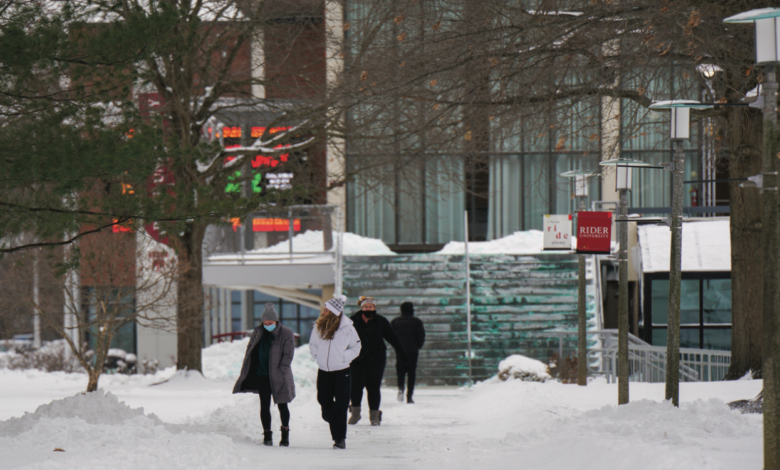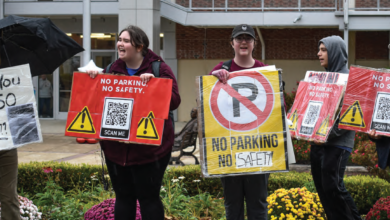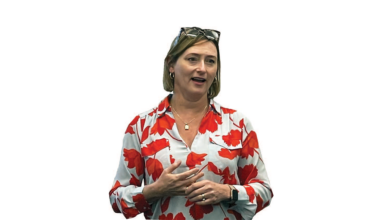
COVID-19 implementation team adjusting to omicron challenges
By Shaun Chornobroff
At the turn of the new year with students and professors home for winter break, the highly contagious omicron variant of COVID-19 caused a nationwide spike of positive cases, leading to widespread fears for the spring semester for colleges around the country.
After its efforts aided Rider in avoiding a large outbreak of positive COVID cases in the fall semester, the school’s COVID-19 Implementation Team’s latest task in the ongoing pandemic was to prepare the university for its return with yet another potent variant causing havoc.
The team had to make decisions about starting classes in-person, adjust to a trove of new guidelines from state and national authorities as well as concerns about quarantine space with an influx of positive cases a possibility at any time.
“It’s like you’re moving at 75 miles an hour every day, with it feels like no end in sight,” said Rider’s Vice President for Strategic Initiatives and Secretary to the Board Debbie Stasolla, who also serves as one of the leaders of the implementation team. “In terms of keeping up with the changing nature of different variants, what we know of the different variants and the surrounding circumstances that makes them challenging.”
An in-person start
When colleges like Princeton, Rutgers and Monmouth among many other schools in the state of New Jersey decided to start their semester online, Rider sent its students into classrooms on Jan. 24 for in-person instruction on the first day of classes.
“We felt that by Jan. 24, we would be past the height of omicron,” said Stasolla, who serves as Rider’s vice president of strategic initiatives and secretary to the board. “And our philosophy continues to be not only supporting the safety and well-being of our community but also to support as normal operations as possible. So we need to learn to live with this virus.”
In an email sent to the student body on Jan. 11 announcing the plan to start the semester in person, the implementation team stated that the plan was, “based in part on our Jan. 24 start date, which should ideally coincide with a reduced transmission rate of omicron and be past the peak of infections in our region.”
New Jersey saw more than 21,000 positive COVID-19 cases on Jan. 11, according to the state’s COVID-19 dashboard. Less than two weeks later when professors welcomed students into classrooms, positive cases had plummeted to below 10,000 statewide.
Changing Guidelines
As the virus mutated and caused a nationwide outbreak in cases and crisis in available tests, the Center for Disease Control (CDC) and the New Jersey Department of Health updated guidelines that treat students who have not received a booster as if they are unvaccinated for the spring semester.
During the fall semester if a fully vaccinated student was a close contact they may not have had to quarantine, but with the most recently updated COVID-19 guidelines, those who are fully vaccinated but have not submitted proof of a booster will be placed into quarantine if they are identified as a close contact.
The first update of Rider’s COVID-19 dashboard displayed nine students in quarantine as of Jan. 28 and started keeping data on the first day of classes.
Omicron is an extremely contagious variant of COVID-19 and as a result, Stasolla is expecting a rise in cases at the school in comparison to the fall semester, which saw a surprisingly low 64 cases throughout the entire semester and the university never experienced more than 16 cases in a single week.
Stasolla’s fears were quickly proven accurate. In its return for the spring semester, Rider recorded 24 positive cases, the most the university has seen in a single week since November of 2020.
To combat the expected rise in positive cases and quarantine numbers, Stasolla and the implementation team decided to create more space for quarantine and isolation by emptying unvaccinated students of Poyda Hall and placing them among the vaccinated and boosted students in normal residence halls.
“As more information and studies came to light, it was clear to us that [unvaccinated students] was not a big risk for our community, our bigger risk in light of how contagious omicron is, was not having sufficient space to accommodate and with the change guidelines to accommodate, quarantined and isolated students. So we felt that was a big risk not to have sufficient space,” Stasolla said.
Students who test positive with COVID-19 will have to quarantine for five full days and can end as long as students are fever-free for a whole day and have improvement with other symptoms, according to Rider’s Resolved and Ready guidelines.
The guidelines also explain that students who live within two hours are expected to quarantine at their homes.
Of the positive COVID-19 cases that found their way to the university in the fall, more than 90% of them were among vaccinated individuals and the school found “very few” positive cases during its weekly surveillance testing, Stasolla explained.
As the new semester starts and the implementation team has to oversee several changes to protect the community, they’re well aware that the challenges of omicron are just the latest one it faces and is likely not the last.


